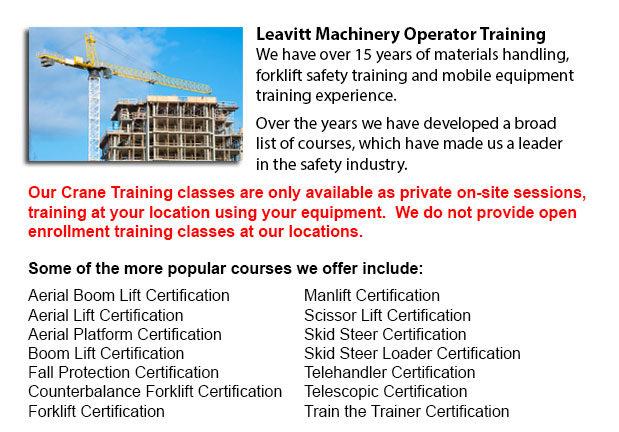
Brampton Crane Certification - The Crane Certification Program covers the industry recommended content that would teach the safe and efficient operation of cranes. The person will train in the following: how to identify cranes and their component parts; pre-operational, operational and post-operating requirements; how to determine overall lift capacity; rigging components and inspection/rejection criteria; and needs specific to the work location where the individuals training will be working.
The requirements that should be carried out before operating a crane like for instance assigning authority for the pre-operational check; doing the sequential pre-operational check based on the manufacturer's specifications or specifications certified by a professional engineer; checking the log book for comments; inspecting the work place for hazards and obstacles; inspecting cables, hooks, chains crane movement and safety latches; ensuring the proper functioning of operational controls; and learning how to ensure the disconnect switch/isolator of the crane is functioning right.
The requirements to operating a crane will include the identifying of roles and responsibilities, and the determination of the requirement for a formal lift plan. The trainee will know how to do danger assessments for the different environmental conditions, physical conditions and employees. Subject matter includes determining when to seek competent support, the safest route and destination of loads, and load weight and centre of gravity.
It is vital for individuals training to be able to identify an over-capacity lift, choose correct rigging machine, know load limitations, and determine a safe location from which to operate. Trainees would review both universal and site-specific crane signals for lifts, and techniques for traveling, lifting and loading. Right maintenance practice will also be covered.
The trainee will undergo an examination to test their understanding of emergency response procedures for different conditions, specially electrical or mechanical failures. They would be asked to describe shut down and parking procedures for security and safety, to follow lock out and tagging procedures, and to explain why near misses are reported and recorded to the right individual. Log book records must be maintained.
Individuals training will develop knowledge of rigging, particularly, establishing who has authority and responsibility for rigging, identifying various kinds of rigging, knowing load capacity ratings and storage procedures.
The requirements after operation of the crane will be taught too, learning to enter the deficiencies and defects; and to log the history of maintenance and service records, in accordance to the provincial, federal and state codes requirements.
Site-specific requirements can be incorporated into the safety training program based on the employer's needs.
-
Brampton Aerial Boom Lift Ticket
Brampton Aerial Boom Lift Ticket - Aerial lift trucks might be used to accomplish several different tasks executed in hard to reach aerial places. Many of the tasks associated with this style of jack include performing routine maintenance on building... More -
Brampton Aerial Lift Train the Trainer
Brampton Aerial Lift Train the Trainer - The Aerial Lifts Train the Trainer Certification Program would teach trainers how to efficiently train operators in safe industrial mobile equipment operation. Trainers are provided with in-depth instruction o... More -
Brampton Zoom Boom Training
Brampton Zoom Boom Training - Zoom Boom Training is intended to train operators on variable reach forklifts. The goals of the training are to be able to impart an understanding of the physics of the machinery, and to be able to outline the operator's... More -
Brampton Heavy Equipment Operator Training
Brampton Heavy Equipment Operator Training - Heavy equipment operator training facilities that provide good standards within the industry, providing field performance work and additional machinery training are really sought after training features. S... More -
Narrow Aisle Forklift / Order Picker Training / Electric Pallet Jack / Electric Pallet Truck Training in Brampton
A pallet haul is equipment built in particular for moving pallets of irregular weights and dimensions. They may be used in conjunction with cranes, forklifts and other heavy duty equipment as an appendage piece or to be employed on their own. Pallet... More -
Brampton Overhead Crane Safety Training
Brampton Overhead Crane Safety Training - Overhead crane safety training equips operators with knowledge and skills regarding crane safety measures, accident avoidance, materials handling, and equipment and stock protection. Trainees will learn the k... More -
Brampton Crane Safety Training
Brampton Crane Safety Training - Companies and crane drivers have to know the problems associated to crane safety. Legislation provides rules for the safe maintenance, operation and inspection of lifting machines across North America. Crane Safety co... More -
Brampton Telehandler Training
Brampton Telehandler Training - Telescopic handlers normally known as telehandlers for short, are a really popular piece of heavy construction machinery. They are usually utilized in the construction and agricultural trades. These machines have farth... More

Forklift Certification Brampton
TOLL FREE: 1-888-254-6157
Brampton, Ontario
forkliftcertificationbrampton.com
Email Us
About Us


